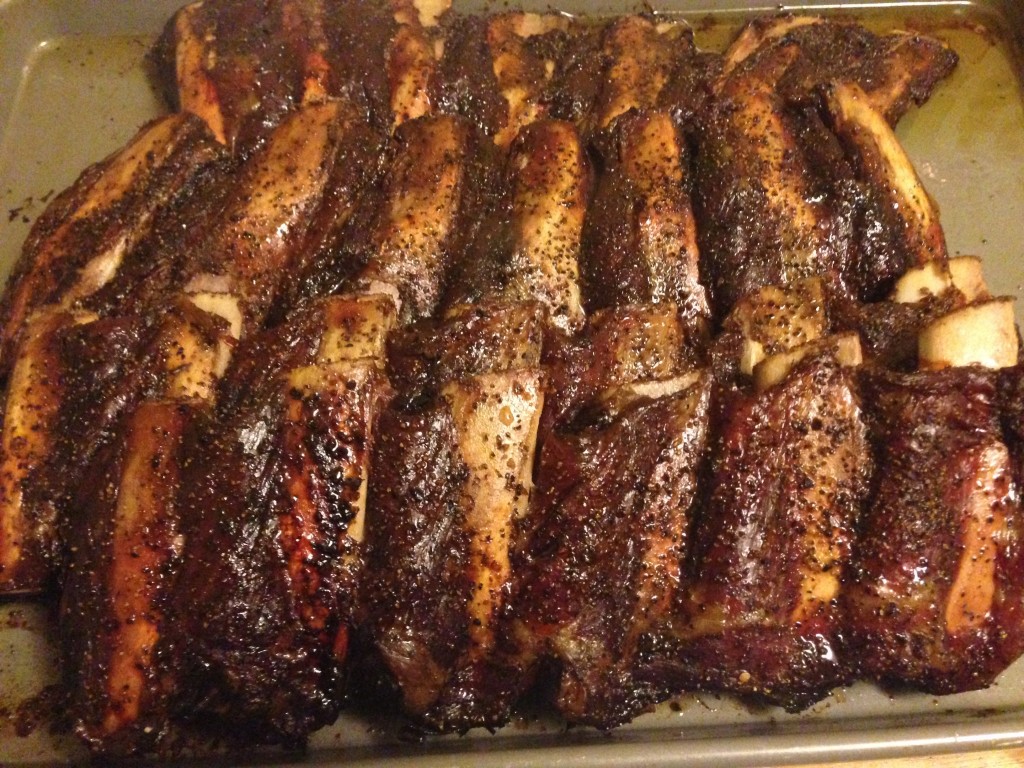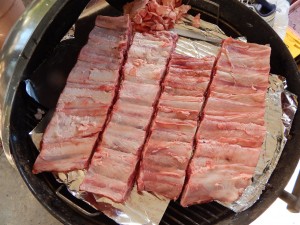In the first part of this article, I discussed the basic idea behind barbecuing beef ribs. In this final section, I’ll discuss the details of how you can do it on a home charcoal smoker or charcoal grill.
There are various kinds of beef ribs. As beef ribs are less popular than pork ribs, you may not have the option of choosing the cut. Most commonly, you’ll find beef short ribs (or plate short ribs). These are the toughest cut of beef ribs, with the most connective tissue, but also the flavorful when properly prepared. This is what I barbecue when I make beef ribs.
Beef back ribs and chuck short ribs are two other cuts of beef ribs. These are meatier cuts, but less flavorful. If the ribs are labelled simply beef short ribs, they are usually plate (not chuck) short ribs. When selecting your ribs, look for ribs that are as meaty as possible. Plate short ribs contain less meat than the other cuts, so look for the meatiest you can find.
The Wood
In a charcoal smoker, you burn charcoal for the heat and add chunks of hardwood for the smoke. Oak or pecan work great for smoking beef ribs, and the wood should be soaked in water overnight before you barbecue the ribs. I use large (fist-sized) chunks of hardwood because they will smoke slowly over the long cooking time for ribs. For an eight hour smoke, I will use 3 or 4 chunks of hardwood over the course of smoking the ribs.
Prepping the Ribs
To prep the ribs, you will need to remove the membrane and trim any excess fat. The membrane is a whitish layer on the bone side of the ribs. To remove it, flip the ribs membrane side up and insert a dull knife (or any type of metal probe) under the membrane. Wiggle the knife around and lift a bit to start separating the membrane from the meat. Once you’ve got a start, grip the membrane firmly and pull with a steady pressure. The membrane should peel off in a single sheet.
It should . . . but sometimes it doesn’t. Sometimes the membrane is easy to separate. Other times it becomes a hassle and you have to pull off little pieces of it at a time. If the membrane proves extremely difficult to remove, I just leave it. The meaty side of the ribs can get enough smoke to make decent ribs. (The membrane side will be a little chewy, but not inedible.) Trim off any excess fat.
The “Recipe”
Once you have the membranes removed and fat trimmed, apply your dry rub. Your dry rub can be as simple as salt and pepper. Most often, I use seasoned salt and seasoned pepper. The seasoned salt is basically salt with a little bit of paprika, onion, and garlic mixed in. Seasoned pepper is basically black pepper with some red bell pepper flakes thrown in. Coat the meat generously with the rub.
Preparing the Smoker or Grill
To barbecue beef ribs the way I do, you’ll need a smoker or grill, about 17 lb. of charcoal briquets (the usual sized bag), a “chimney” starter, 3 or 4 wet hardwood chunks, and metal tongs.
To prepare my smoker, I line the water pan with aluminum foil and fill it with water. If you’re using a charcoal grill, find something to use as a water pan. Any metal bowl or pyrex dish should work fine. You’ll want to have some type of thermometer to measure the temperature inside the smoker, near the meat. If you’re using a charcoal grill, you can insert a dial thermometer into one of the top ventilation holes or set an oven thermometer on the grill grate.
Build a fire in your smoker using charcoal briquets and let it burn down to coals. You don’t want the fire to be too hot, so use fewer briquets than you do when grilling meat. About 20 minutes after lighting the fire, light another 15 to 16 charcoal briquets in your chimney. About 20 minutes after that, hopefully the coals in your smoker or grill will be ashed over and the internal temperature around 240 °F (116 °C) or lower. Place the ribs in the smoker, either in a rib rack or flat on the grate. If you’re laying the ribs flat, put the meaty side down.
Maintaining Temperature
As the meat is smoked, the charcoal will burn down and the temperature inside the smoker will drop. When it gets too low, add burning briquets from the chimney to the smoker to bring the heat back into range. Then, add fresh briquets to the chimney to use later.
On my smoker, I let the temperature drop to around 220 °F (104 °C), then I add 12 to 13 briquets to bring the temperature back up to 240 °F (116 °C). On my grill, I only need about 6 to 8 briquets. The briquets must be completely ashed over before adding them or they will contribute an overly aggressive smoke character. After adding the burning briquets, the remaining hot coals in the chimney will ignite the next batch of fresh briquets.
Keep an eye on your smoker temperature and count the number of briquets you add each time and eventually you will know how many you need to raise the temperature to 240 °F (116 °C). Add 3 to 5 to this number so you always have burning coals left over to ignite the next batch.
On my smoker, the briquets are added through a door on the side. I use metal tongs to transfer them. On my Weber grill, I need to crack the top open just enough to drop coals through the grate near where the grate handles are. If you have another type of grill, you need to somehow arrange it so you can drop in briquets during the smoke. Whatever your situation, try to minimized the amount of time the smoker door is open or grill lid is cracked. And don’t remove the grill lid completely when you refresh the fire.
At the same time the new coals are added, I like to mist the meat with a spray bottle. Just one or two quick squirts is all that is needed. On my smoker, I simply insert the nozzle of the spray bottle into one of the top vents. On my grill, I’ll just spritz the meat gently from the side, keeping the lid cracked as little as I can manage.
Every couple of hours, I add a new chunk of wood. This gives me the level of smoke I like in the beef ribs, but certainly this can be adjusted up or down for taste. Changing the wood every two hours gives a level of smokiness that’s on the middle to low end, compared to most barbecue restaurants. It’s smoky, but not so smoky as to obscure the flavor of the beef. When you add the wood, make sure to set it directly on top of some burning coals, so it will smoke. You may need to add a couple extra briquets when you add the wood to keep the temperature steady.
You need the ribs to reach an internal temperature of at least 200 °F (93 °C). For that, you’ll likely need to smoke them around 8 hours if your smoking temperature hovers around 230 °F (110 °C). During that time, you’ll keep adding burning coals to the smoker every 30 minutes or so, and starting new briquets at the same time. You will also mist the ribs lightly with a spray bottle of water each time you add coals. Watch the peak temperature about 5 minutes after adding the coals and adjust the number of coals you add up or down as needed. Add new hardwood chunks every couple of hours.
When you’re nearing the end of the smoke, check the internal temperature of the meat. If you’re close, keep smoking at around 230 °F (110 °C). If you’re more than 15 °F (~8 °C) low with 30 minutes left to reach 8 hours, increase the smoker temperature to 250–260 °F (121–127 °C) to finish the ribs off.
After you pull the meat off the smoker, letting it rest for about 20 minutes before serving will let the juices inside the meat redistribute. Beef ribs will keep in the fridge for at least several days. When you reheat them in the microwave, put some water on the plate under the ribs and cover the ribs with a paper towel. This will make them slightly more moist.
—
Related Articles
Barbecued Beef Ribs (I: Theory)





I like to alternate between lump charcoal and small cured chunks of hardwood. The straight hardwood burns a bit dirtier at first, but if you let the initial resins burn off (white and grey smoke) then the blue smoke seems to give a very ‘clean’ smokey flavor. You would need to use a bit more straight wood than lump charcoal for a long smoke. I find that with a pan of moisture (beer or water or cider) I don’t need to supplement the moisture by soaking.
So hard to beat the smoke ring on a nice thick bit of protein!